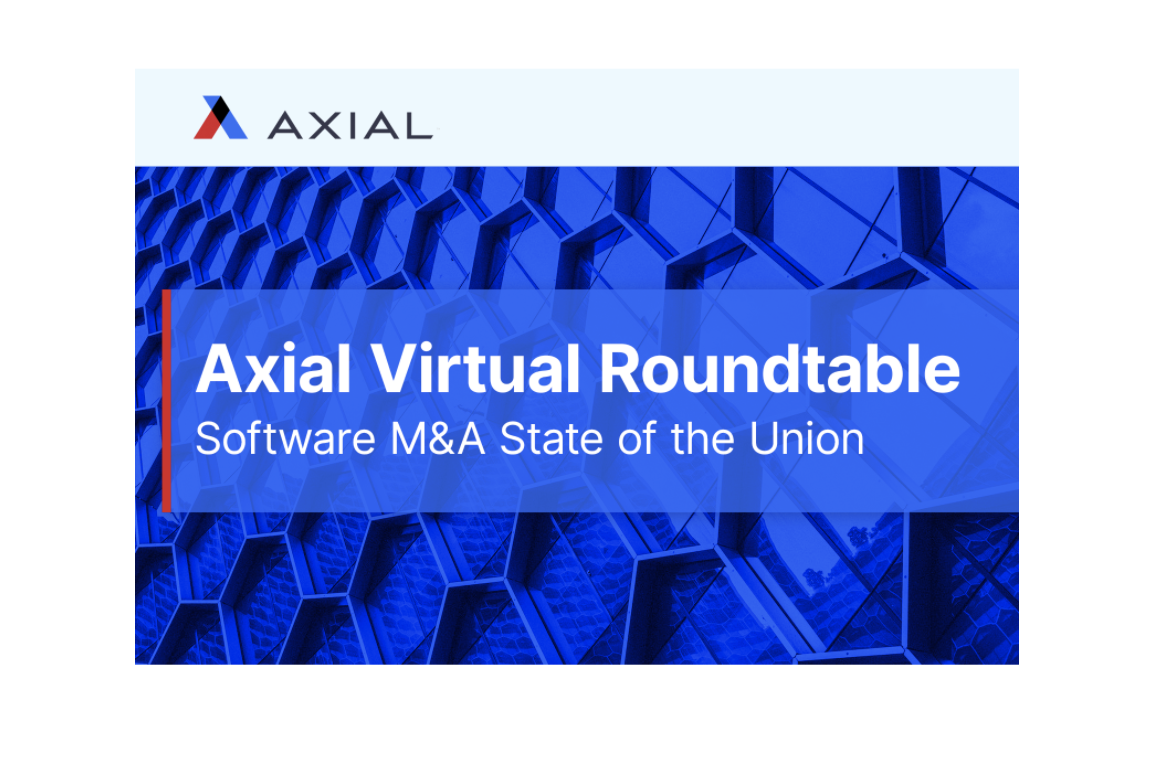The public markets have been a rollercoaster of volatility so far this year. The cocktail of geopolitical tensions, inflation, and the Fed’s impending interest rate hikes (among other things) have contributed to the steepest increase in the VIX index since before the pandemic. Technology and software companies, in particular, have contributed significantly to these recent market swings. Two weeks ago, Facebook shares took a 26% nose dive in a single day, wiping out over $250B in value.
How is all of this impacting software investments in the private capital markets?
We recently sat down with 5 Axial members to discuss current trends in software M&A. Topics of discussion included the correlation between public and private capital market activity, debt financing and the cost of capital, and what direction the broader software industry is headed in the near future.
Thank you to the following members who participated in the discussion:
- Nat Burgess, Managing Partner, Techstrat
- Nelson Norley, Associate, Lock 8 Partners
- Stan Gowisnock, Managing Director, Focus Investment Banking
- Austin Neudecker, Managing Partner, Weave Growth Partners
- Aaron Solganick, Founder, Solganick & Co.
Video
Audio
Introductions: 00:00 – 4:15
Impact of public software company price volatility on private lower middle market company valuations: 4:14 – 16:15
- Nat Burgess, Techstrat: There is a lot of skepticism about software companies on the periphery trying to access public markets – the opportunity excitement within this range is sloping downward, however lower middle market enthusiasm is still high despite volatility.
- There is also a time lag between what happens in the lower middle market and public market trends, so there has not been any significant change in broker strategy in terms of valuing private software companies.
- Austin Neudecker, Weave Growth Partners: Weave takes a long term view on investments and acquisitions and public markets do not affect them substantially. New competition on the buy-side of capital markets is the main driver of valuation increases.
- They also invest in main street businesses that use software to improve them. They see LMM business adoption of software as the future.
- Stan Gowisnock, Focus Investment Banking: Private equity companies are focusing on technology, and EBITDA multiples are through the roof despite the volatility in the public markets.
- Technology and software acquisitions should be very active in the next couple of years due to the growth opportunity of their investments.
- Nelson Norley, Lock 8 Partners: Lock 8, similar to Weave, focuses on long-term investments that have stable growth trajectories. They do not pay close attention to public markets and focus more on the inherent value of the private companies they pursue.
- Nat Burgess: Valuations in the private market are based on tangible EBITDA multiples and are not nearly as high as the 20x – 50x revenue valuations in the public markets.
- As Austin mentioned, competition on the buy-side is the biggest factor in software valuations in the lower middle market.
- Aaron Solganick, Solganick & Co.: Software and Technology firms in the private markets are getting more offers than ever and there is a lot of dry powder that will be utilized in the future to continue to drive these offers.
- PE firms raised $330 billion and spent $1 trillion last year, which demonstrates the incredible growth in funds that will be directed towards software and technology.
- Nat Burgess: Another topic to think about is the relationship between M&A activity and unemployment. As long as there’s labor shortage pressure on firms, there is another support for the market that is immune to fluctuations in the NASDAQ.
- Peter Lehrman, Axial: There is a huge labor shortage which is being taken into consideration in all industries including software and technology.
Financing – Cost of capital and debt financing: 16:15 – 20:40
- Aaron Solganick: Nothing is being repriced, as the cost of capital is still at record lows even with interest rate increases planned in March. Private SaaS capital firms are joining the market and even traditional banks like Comerica Bank are now financing software deals, which didn’t happen five years ago. These new additions to the markets are keeping the price of capital relatively steady.
- Austin Neudecker: Increased dry capital is being deployed on the debt side as well, so competition is not only increasing on the equity side but also for debt financing.
- Nat Burgess: The ability of a fund to skillfully put together a debt package gives them a huge competitive advantage as a debt provider. That is not Techstrats specialty so they are increasingly relying on the PE firms to do so, which only brings in more buy-side members to the market.
Portfolio company growth in software, in particular add-on strategies: 20:40 – 34:07
- Austin Neudecker: For Weave, utilizing add-ons really depends on the company. They recently purchased an e-commerce store where it would not make sense to acquire add-ons but it certainly could be applicable in other branches of software, for example MSP’s.
- Nelson Norley: Lock 8 does not focus the core of its business on add-ons due to the smaller nature of their investments and instead focus on organic rather than inorganic growth.
- Stan Gowisnock: Focus is heavily invested in MSP’s, so add-ons are commonplace for them. He has also seen a recent trend of MSP’s coupling up prior to their sale in order to increase their EBITDA multiples.
- Peter Lehrman: Who is organizing the coupling of the MSP’s?
- Stan Gowisnock: Often, Focus will advise their clients to combine into a larger entity in order to increase multiples to get over certain thresholds of EBITDA.
- Focus has also seen instances of companies coupling on their own terms with the help of liaisons like Focus or other firms.
- Austin Neudecker: Weave is seeing similar occurrences of coupling in order to get above certain EBITDA thresholds, which sometimes causes concerns with integration.
- Weave deems it important to bring value to the seller through tailored strategies on integration which is something they have been focusing on.
- Nat Burgess: Although merging is sometimes beneficial, software companies are weapons of mass disruption, so sometimes keeping the company small and adding value to other non-software businesses is more powerful than trying to combine with other companies, thereby diluting the focus of the company.
- Similarly to Weave, Techstrat sees some skepticism from sophisticated buyers about these coupling deals due to a lack of integration, even if EBITDA falls over a certain threshold.
- Stan Gowisnock: One way to combat these fears is ensuring that merging businesses are on similar platforms and are well aligned, as this mitigates the risk of integration.
Excitement around the future of software: 34:07 – 55:45
- Aaron Solganick: Data analytics is very interesting because every company, software or not, is integrating data into their business. Date drives other related processes like AI and machine learning.
- The movement of information to the cloud is an ongoing and interesting process.
- Cybersecurity threats are a growing implication of the increased use of technology both in office and at home, so Solganick is looking into that as well.
- Another exciting industry that has macroeconomic implications is supply chain technologies that are focused on automating processes.
- Peter Lehrman: How does cybersecurity take shape, specifically in the lower middle market?
- Nat Burgess: In the LMM, there are two players in the cybersecurity space. The ones who build a wall so that threats cannot enter, and the ones who monitor threats already inside the wall, and take reactionary measures to those threats.
- There is now a shift from building the silver bullet in order to block threats completely, to maintaining long-term access to the customer to help protect them from threats over time.
- Austin Neudecker: With COVID pushing everyone onto their personal devices, there is no longer the well defined wall there once was, which creates new challenges and opportunities for companies like Nat just mentioned.
- Due to these changes, Weave is delving deeper into the related field of fraud and risk.
- Nelson Norley: Potential future regulations in the identity space will also have an impact on business especially the way they are handling customer data and keeping that data secure from cyber threats.
- Austin Neudecker: It’s interesting to see how different industries are progressing in terms of technology adoption. Many are still in the digitalization stage. The next stage moves into the analytics phase once they have the data available. Finally, there is automation, which is the stage where the majority of companies are currently.
- Peter Lehrman: Are you focused on the businesses that are in these various stages or are you more focused on the companies that make the transitions between the stages possible for businesses?
- Austin Neudecker: Weave is interested in both types. They have a PEO business that still writes 25% of their checks in paper. They are then also going after the niche business that allows the digitization of medical records that PEO businesses may use, so they’re strategy ranges between both types of companies. .
- Peter Lehrman: Do you see an evolution of software business models from subscription to free-to-use where they can then increase their customer base and use the data that they gather over time to be their main profit driver?
- Aaron Solganick: The LMM will see those business models emerge, however subscription models will be very sticky due to the preference of PE firms for businesses with predictable recurring revenue streams.
- Nat Burgess: To Peter’s point, companies are beginning to turn the data they collect into an asset and Techstrat sold three of these companies in the last year.
- Nelson Norley: Data can not only be sold, but will inform go to market strategies for the software businesses themselves.
- Stan Gowisnock: It is still the case though that many small to medium businesses have no idea how to manage their data or implement tools to help them do so.
- Peter Lehrman: Axial uses a lot of platform usage data which feeds into salesforce helping every aspect of the business to use data to drive decisions. For example, the data piece of Axial’s Salesforce contract value continues to grow year over year. Due to other players entering the market such as HubSpot, Salesforce is more vulnerable now than ever.
- Austin Neudecker: As Salesforce moves vertically to bigger and bigger companies, smaller players that are industry specific are beginning to gain a foothold because of their specialization efforts.
Verticals emerging in the software space: 55:45 – 58:20
- Nelson Norley: Lock 8 is focused on finding businesses with sticky customer bases, not necessarily as fast growing, but with strong fundamentals. They recently acquired an HR tech firm which is purpose built for a larger firm focus, thereby scaling vertically.
Closing remarks/Summary: 58:20 – 59:37
- Peter Lehrman: Business as usual in the lower middle market with minimal impact from public market activity.
- Interesting phenomenon of businesses coupling up to pierce EBITDA thresholds pre-transaction in order to increase their multiples and attract larger valuations from the buy-side.
- The future seems to focus around data analysis and technology adoption with a stronger focus on security and risk mitigation to prevent cyber security threats.

